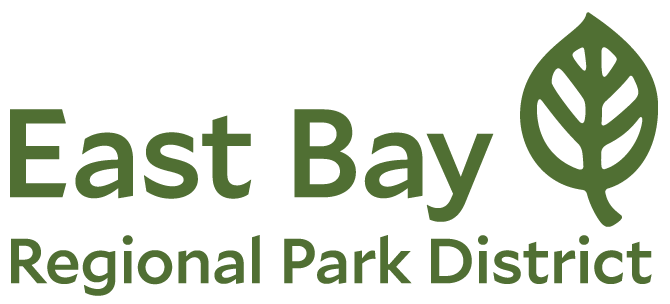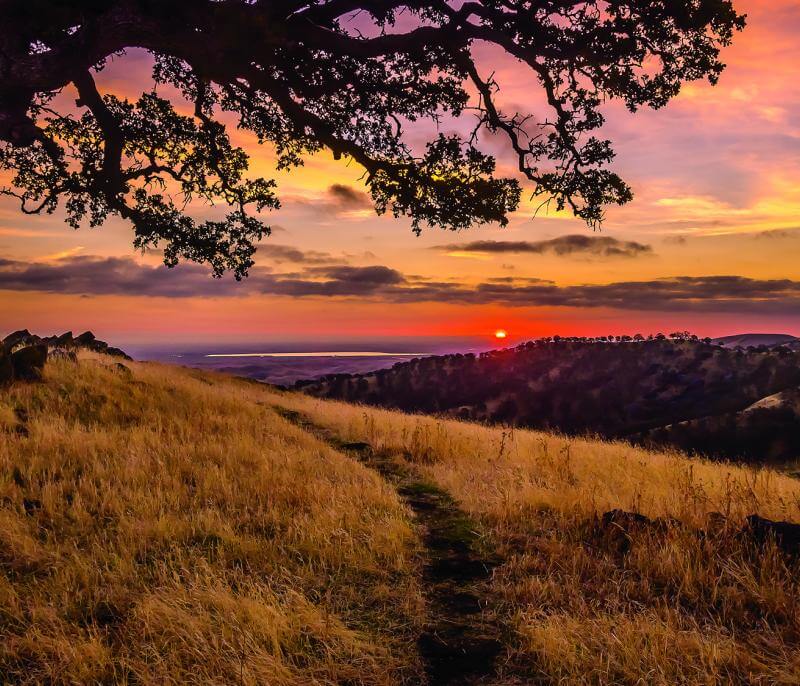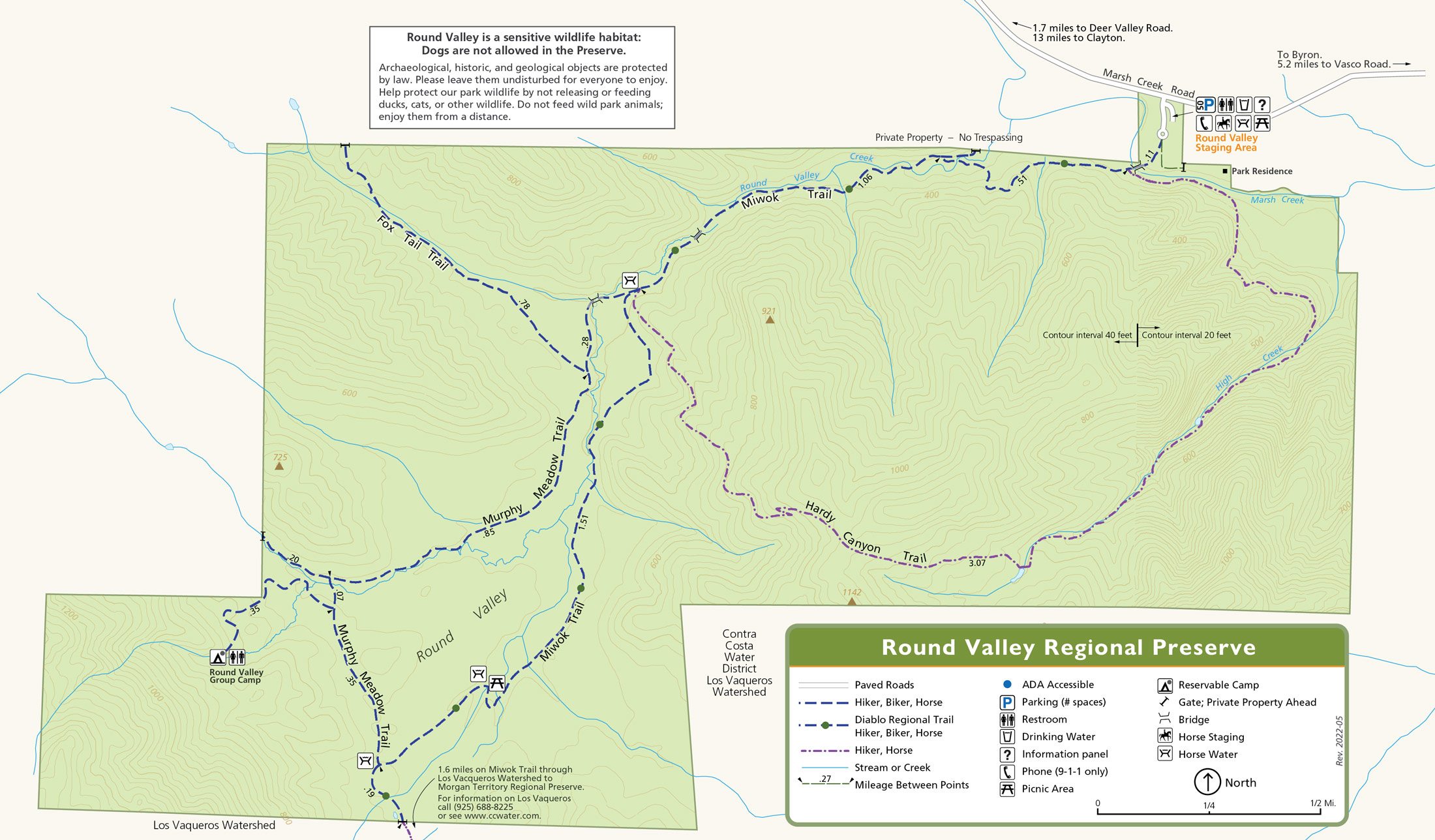Overview
January: 8 a.m. - 5 p.m.
Feb. 1-Mar. 12: 8 a.m. - 6 p.m.
Mar. 13 - Apr. 17: 8 a.m. - 7 p.m.
Apr. 18 - Sept. 5: 8 a.m. - 8 p.m.
Sept. 6 - Nov. 5: 8 a.m. - 7 p.m.
Nov. 6 - Dec. 31: 8 a.m. - 5 p.m.
Parking: No fee
19450 Marsh Creek Road, Brentwood, CA
Toll Free: 888-EBPARKS
(888-327-2757), option 3, extension 4556
Internet & Cellular Access

Public WiFi is not available.
Check AT&T, T-Mobile & Verizon Coverage.
Select 'Map Layers' and switch on 'No Data Coverage Areas'
Park Activities
The area that is now Round Valley Regional Preserve was once home to California Indians. It was probably a boundary between several different tribal groups, an area where members of East Bay and San Joaquin Valley groups met periodically to trade and socialize. Evidence of Native American use has been uncovered at several archaeological sites within the valley.
Notice: No dogs allowed.
To Reach The Park
Park Accessibility
The restrooms and drinking fountain in the parking lot are wheelchair accessible.
Attractions
Vegetation
The 2191-acre preserve contains non-native grassland, oak woodland/savannah, shrubland and riparian woodland plant communities. The grassland occurs interspersed with extensive stands of blue oak woodland/savannah. Round Valley itself is primarily annual grassland with valley oak lining the intermittent drainages. Non-native grasses, inadvertently introduced to California by early settlers, comprise the annual grassland flora. The dominant grasses are annual ryegrass, wild oats, soft chess, and ripgut brome, with wild barley, foxtail chess, red brome, silver hairgrass, and annual bluegrass occurring in lesser amounts. Native and non-native wildflowers occur in spring.
The steep, northeastern-facing slopes in the southwestern portion of the preserve support mixed oak woodland and chamise/black sage/manzanita chaparral. Riparian and wetland vegetation consisting of moisture-dependent grasses, rushes, herbs, shrubs, and/or trees occur along Round Valley Creek, which is a tributary of Marsh Creek originating in the uplands surrounding Round Valley.
The southwest corner of the preserve supports mixed oak woodland containing blue, valley, coast live, interior live, and black oak; California buckeye; and California bay laurel.
Riparian vegetation occurs primarily along Round Valley Creek, which the Miwok Trail parallels beginning about one-half mile from the staging area. The creek flows until late spring or early summer, after which the water pools at intervals along the streamcourse. Tree cover along the banks is sparse; vegetation includes spikerush, sedge, rabbitsfoot grass, watercress, curly dock, monkey flower, and willow.
Wildlife
Round Valley Regional Preserve is habitat for a wide variety of wildlife typical of that found in the East Bay Area and also some species more common to the Central Valley. As with all California valley and foothill environments, several species in this area have evolved to survive with only seasonal supplies of water and green vegetation.
Mammals in Round Valley include the California ground squirrel, San Joaquin pocket mouse, Audubon's or desert cottontails, and the endangered San Joaquin kit fox. Round Valley is one of the northern extremes of the kit fox range in California. This shy fox, which is on the Federal and State endangered species lists, lives in the sheltered valley but is subject to isolation and resulting local extinction due to elimination of viable corridors and lack of genetic diversity among the small local population. The kit fox is prey to coyotes and red foxes, and dogs can be a disease vector to the kit fox. Like other scavengers, it is susceptible to secondary poisoning. The challenges faced by the kit fox and its future in the East Bay is one of the primary subjects of the ongoing Alameda-Contra Costa Biodiversity Study, and the Park District is playing a major role in protecting the fox by protecting its habitat in Round Valley.
The preserve is also home to nesting golden eagles, which are protected by State and Federal law. The golden eagles feed on ground squirrels, and with the local burrowing owls, are a state "Species of Special Concern." Burrowing owls nest in ground squirrel burrows and feed on mice and insects.
Ponds and streams in Round Valley support the federally threatened California red-legged frog, western toads, western pond turtles and Pacific tree frogs. These species breed with the onset of winter rains, and burrow into the mud or use rodent holes for hibernation during the dry summer months.
Geology
The bedrock geology of the preserve is Cretaceous Panoche shale and sandstone with deposits of recent alluvium on the surface in valleys and creek drainages. The preserve has small amounts of high-quality soils, located mainly in the level areas along Marsh Creek and in the valley proper. Most of the soil, however, is of a lower quality suitable only for range, wildlife and watershed uses. The Marsh Creek (Mount Diablo) Fault is located about two miles southwest of the preserve. This fault has produced small earthquakes; two recent significant earthquakes (magnitude 5.5 and 5.6) occurred in 1980.
Park Activities
The preserve is open for hiking, horseback riding and bicycling (with some restrictions). The climate at the preserve is arid and temperatures commonly exceed 100 degrees Fahrenheit in the summer months. Be prepared for the summer heat: use sunscreen, wear a hat and loose-fitting clothing, wear good hiking shoes. Drinking water is available at the staging area. Be sure to carry plenty of water with you during your hike.
Camping
The park features a backpacking site for groups of up to 25 people. There is non-potable water (boil, treat, filter or bring your own water) available at the site. There are leveled tent spaces, picnic table and a ADA accessible restroom. It is a 3.6 mile hike-in to the site from the Marsh Creek Staging Area. Reservations can be made 2 or more business days in advance. View the Camping page for more information, and call Reservations to reserve.
Dogs
Due to the sensitive nature of the wildlife habitat at Round Valley, dogs are not allowed in the park.
Upcoming Events
History
The land was purchased in 1873 by Thomas Murphy, an Irish immigrant who established a ranching and farming operation. Murphy's grandson, Jim Murphy, sold the core 700 acres of Round Valley to the East Bay Regional Park District in 1988. It was his wish that the land be preserved in open space for public enjoyment, rather than used for residential development, or, as was once proposed, a refuse disposal site. A few old pieces of farm equipment in the preserve date to the late nineteenth century or early twentieth. Remember that all archaeologic and historic objects in the preserve are protected by law; please leave them undisturbed for others to see.


